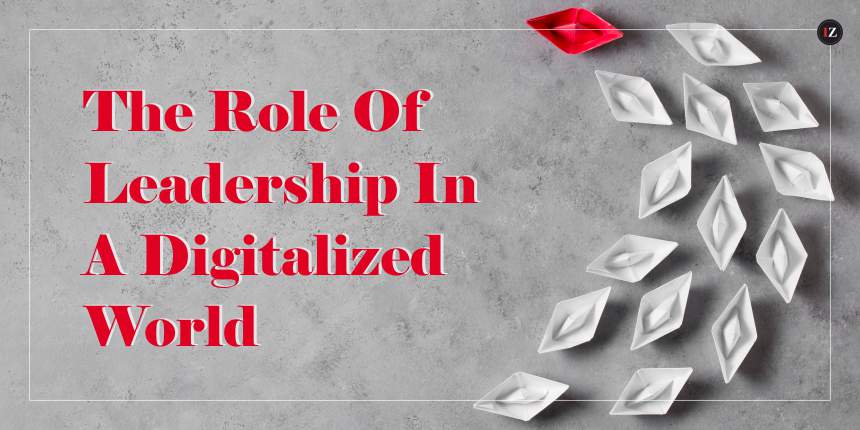The Role Of Leadership In Digitalized World
For most companies, digitalization begins as an outside-in process: Leaders identify a fundamental change in the competitive environment and move to counter a potential disruption or, better yet, gain an advantage by seizing on new opportunities before competitors do.
Leadership in the analog economy was relatively straightforward: competitors were largely fixed, investment flows were primarily into established companies, the pace of innovation was tame and primacy was placed on the efficiency of operations at scale.
Staying ahead of rapid technological advancements is integral to business success in today’s digital era. But keeping up and following the right course has its challenges when daily operations impinge upon any efforts to think ahead. Some of the leaders understand digital strategy and big thinking, which you can use to get ahead as follows:
Digitalization Comes Down to Talent in 4 Key Areas –
1.Customer-Focused Business Objectives
The complexity and urgency of getting customer experience right means that any help with best practices, data management and domain frameworks will save you money, speed up progress and reduce risk.
Satisfying and even better, delighting customers is the number one goal of every person within a company, whether their job is directly customer-facing or not. That means you have to approach everything from the customer’s point of view.
In case, if a clothing store’s customers are demanding better digital experiences online, it might transform its back-end to have more accurate and up-to-date inventory data. This would better unite in-store and online properties so the store could offer a seamless service where customers could “buy” clothes online, have them delivered to the store, and try them on in a risk-free way.
Customers continue to put enormous value on organizations to provide the right experience at the right time and have increasingly little patience for anything else.
2. Strategy Beyond Automation
Digital leaders understand the disruptive potential of technology, in particular the potential for digital business models to upend existing markets. Executives need to understand the applications of digital capabilities in terms of their fullest strategic impact. In many cases, this means going beyond traditional ways of thinking about technology-driven automation.
While automation of business processes remains an important element of successful digital businesses, many executives make the mistake of confusing automation for transformation. This runs the risk of ceding opportunities to competitors which use technology to bring materially different value propositions to market.
In order to challenge existing models, digital leaders must first understand the new opportunities available through new technologies. It is a pre-requisite for leaders to possess at least a basic mastery of the technology domains which have primary relevance to their industries. Artificial intelligence (AI), the internet of things (IoT), blockchain, 5G, social media, e-commerce and other technology domains represent different opportunities and risks across sectors.
Given the highly dynamic nature of the digital economy, many digital projects and investments will not pay off, so digital leaders understand the need to develop a larger portfolio and pipeline of digital experiments. This simulates the growing volume of digital competitors and drives a culture of learning, speed, and transparency around investments. Organizations may accelerate, hold, maintain or exit these investments, similar to options in financial markets.
3. Expert At Building Relationships
Builds trust and collaborates across the organization with diverse stakeholders to enable rapid action. The Driver role ensures that once the vision is set, and the status quo disrupted, that innovation initiatives are executed quickly. This role is also responsible for building talent to enable execution for the future and broadly across the organization.
Digital leaders know that for an organization to successfully transform and win in the digital economy, the entire enterprise needs to participate in the journey. Digital can be intimidating or outright threatening to many people. The best digital leaders understand that they need to ‘meet’ people on those concerns, regardless of where they are in their digital understanding. Connectors translate technical concepts into comprehensible frameworks and create a bridge for people to participate in the organization’s digital strategy.
4. Organizational Change Capability
Stays ahead of emerging trends and technologies, experiments with them personally where possible, and finds ways to apply them to drive transformative change for customers and/or business operations. The Strategist role is critical for envisioning the future and developing a path to winning by creatively leveraging technology.
Focus on shifting the mindset and culture to clear the path without changing the hearts and minds of the organization and helping all employees see themselves in the new digital version of the company, it will be hard to drive lasting change, even on the back of such as a monumental crisis like COVID-19.
Organizations regularly had the luxury of spending months analysing new business opportunities in excruciating detail before starting anything new. The analog economy was much more stable, and successful leadership was largely predicated on the operational management of the traditional business.
One of the primary responsibilities of leaders is to get teams to see that technology can reduce their workload and help add more value to the company. Companies should invest time and resources into training teams in the technology to let them understand its worth rather than see it as a threat to their jobs.
Winning in the digital economy is far more complex. Operations and scale continue to be important, of course, but as digital has revolutionized industries, competition, and business models, a new form of leadership digital leadership is necessary to guide organizations through the transition from analog to digital, and to thrive in the digital economy.




